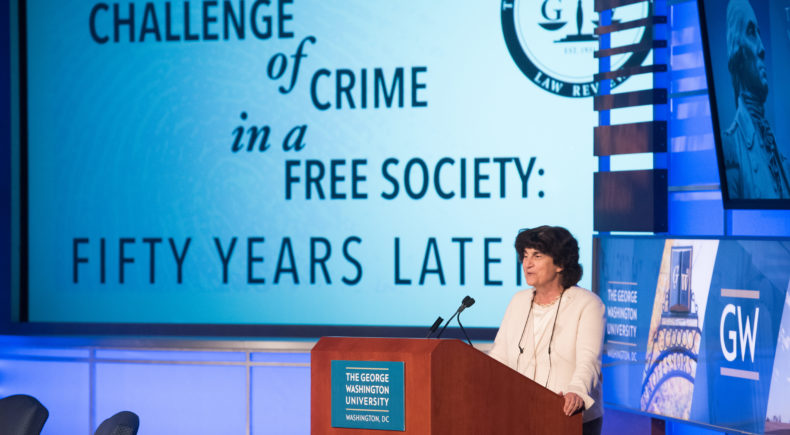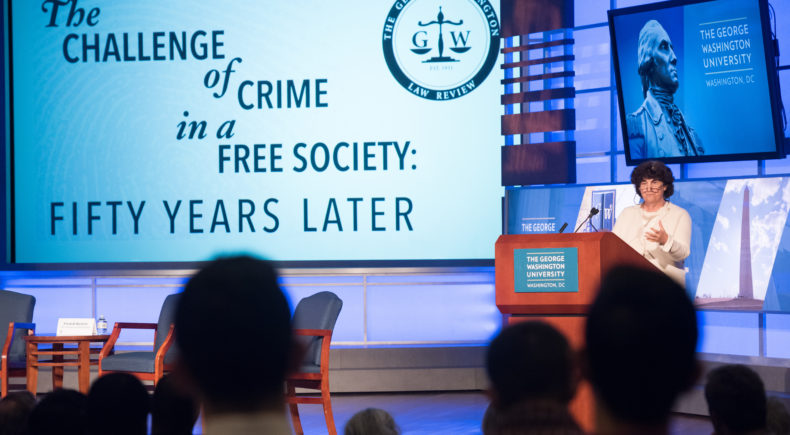Symposium 2017 | Keynote Address by Chief Judge Patti Saris
On October 26, 2017, the Honorable Patti Saris delivered the keynote address at The George Washington Law Review’s Symposium, The Challenge of Crime in a Free Society: Fifty Years Later. Chief Judge Saris, of the United States District Court for the District of Massachusetts and immediate past chair of the United States Sentencing Commission, framed her remarks around The Challenge of Crime in a Free Society, a report produced by President Lyndon Johnson’s Commission on Law Enforcement and Administration of Justice in 1967.
Chief Judge Saris began by offering key insights from the report, noting that it recognized the urgency of the nation’s crime problem and the depth of ignorance about effectively addressing crime. The report also provided insight about how America became the world’s largest jailor and what can be done about it. Finally, the report recognized that effective sentencing depends upon good judges and called for data-based uniform sentences. Chief Judge Saris also noted what the report did not call for: sentencing guidelines and longer sentences.
Chief Judge Saris posited that the report initially seemed to have its intended effect in the 1970s when Congress eliminated most mandatory minimum sentences for drug offenses to allow for more flexible approaches to sentencing. However, the pendulum of justice swung back in the 1980s, when significantly more punitive measures began to be imposed on drug offenders. In 1984, Congress passed the Sentencing Reform Act and established the United States Sentencing Commission. The goals of the Commission were to eliminate unwarranted sentencing disparity and to shift away from rehabilitation and toward crime control. Throughout the late 1980s and 1990s, Presidents Reagan and Clinton signed orders imposing harsh mandatory minimums, which were later incorporated into the United States Sentencing Guidelines.
With this major change in approach to crime came an explosion of the federal prison population. According to Chief Judge Saris, few predicted the effect that this mass incarceration would have on minority communities. Minorities are particularly affected because they comprise a hugely disparate proportion of those convicted of drug offenses compared to their proportion of the general population.
However, now that crime has reached a historic low, the pendulum has swung again. Chief Judge Saris attributes this in part to the budget crisis created by mass incarceration. During her tenure on the Sentencing Commission, federal prisons were thirty-seven percent over capacity. A second factor contributing to this change was the Commission’s recognition that mandatory minimum sentences for drug offenses were too high and applied too broadly, capturing only street level offenders rather than the kingpins for which they were intended. In 2014, the Commission unanimously voted to make an estimated 40,000 prisoners convicted of drug trafficking crimes eligible for a sentence reduction, and on the effective date 6,000 prisoners were released. With both this change and retroactive changes to crack sentencing guidelines, the federal prison population was reduced drastically, from thirty-five percent over capacity to seventeen percent over capacity. Chief Judge Saris also attributes the drastic change of attitude toward crime to a new understanding of how sentencing affects recidivism. A study conducted by the Commission found that the length of incarceration had no effect on recidivism.
Despite progress, Chief Judge Saris still sees room for improvement, and there is a limit to what the Attorney General, the Sentencing Commission, or the President can do alone. She noted that it there seems to be a consensus that our approach to crime needs to change. Additionally, she found it hopeful that the opioid crisis has not created a new wave of mandatory minimum sentences. As indications of avenues for future progress, Chief Judge Saris highlighted the initiation of drug courts and other problem-solving courts, emphasis on alternatives to incarceration, consideration of the special needs of juveniles, and many states’ initiations of sentencing reforms.
In reflecting on the fluctuations of the pendulum, Chief Judge Saris offered three key takeaways from the last fifty years. First, sentences, especially for drug trafficking, continue to be too harsh and are disproportionate to the role many low-level, nonviolent offenders play due to mandatory minimum sentences. The Johnson Commission renounced mandatory minimum sentences and advocated for the use of data, which is an approach that should be considered moving forward. Second, fear about violent crime and drug trafficking continue to play a significant role in policy formation. Today’s policymakers should follow the Johnson Commission’s recommendation that a more holistic approach should be used to address crime and work toward rehabilitation. Chief Judge Saris also noted that treatment programs need to be effective in maintaining public safety to maintain public support. Third, mass incarceration has had a devastating effect on all—and particularly minority—communities.
As considerations for future policy, Chief Judge Saris advocated for careful definitions of crimes to avoid overbreadth. She additionally advocated for the need to consider alternatives to incarceration. However, she noted that in the long run sentencing alone cannot fix crime, and we must instead rely on better policing and attacking the root causes of poverty. Chief Judge Saris warned that policy makers should not wait another fifty years to address the root causes of crime.
This summary was authored by Law Review member Kelley Pettus.





